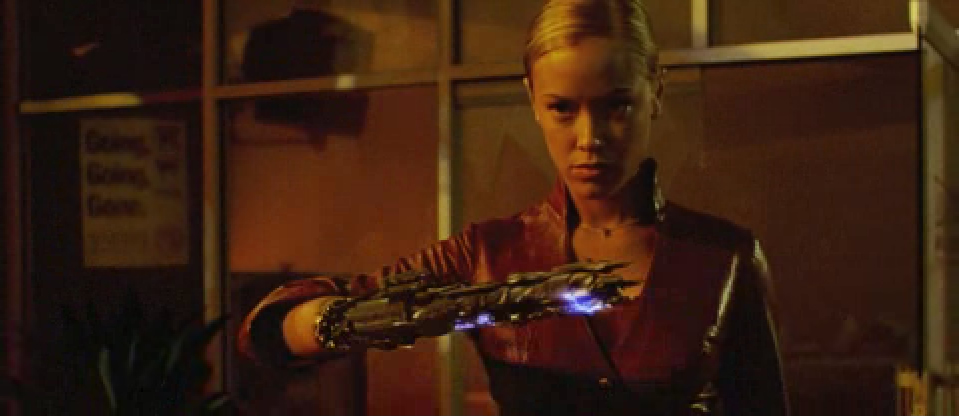
Depictions of Gynoids, Fembots, and Female Cyborgs in SF
Sources Consulted
Sex Objects or Empowered Feminists?: Depictions of Gynoids, Fembots, and Female Cyborgs in SF |
|---|
Nicole Kidman plays Joanna Eberhart of The Stepford Wives(2004) The subject of female automatons in science fiction sparks much controversy because of the portrayals of these figures. Women and the female image have always been objectified and the depictions of female automata have either served to help or hurt this problem. According to one science fiction site, female automata, specifically gynoids, are often depicted in the following three roles: “1.A passive doll, who becomes a mirror of male fantasy; 2.A household companion, practical and capable of performing menial tasks; 3.A woman endowed with spirit, intelligence and emotion” (http://read-and-go.hopto.org/Robotics/Gynoid.html). We find the first two depictions in many of the earlier works of science fiction. Seen as early as the time of the ancient Greeks, the concept of creating the “perfect woman” has been a prevalent theme within literature about female automatons. In “The Mechanical Bride” by Fritz Leiber one of the human female characters is quoted as saying the following: “Didn’t you know? Men don’t want real women anymore. You and I are behind the times, Chernik. We still believe in love. But most men just want beautiful, brainless robots”(Conklin). One of the most popular science fiction novels in which we find female automata depicted as brainless beauties is Ira Levin’s The Stepford Wives. The women of Stepford, Conneticut are being turned into robotic pinups that still manage to be super housewives. Joanna Eberhart, the main character of the novel, moves to Stepford from New York and is determined to foil the mystery of this abnormal town (wikipedia.com). Many readers of science fiction take offense to these portrayals and feel that they further perpetuate stereotypes about the ways in which women should look and act. Other portrayals of female automata support an image that is the exact opposite of the controllable doll. In many more recent works of science fiction, particularly Cyberpunk, female automata are intelligent, gender-crossing, butt-kicking forces to be reckoned with. According to Donna Haraway in “A Cyborg Manifesto: Science, Technology and Socialist-Feminism in the Late Twentieth Century”: “The cyborg is a matter of fiction and lived experience that changes what counts as women’s experience in the late twentieth century…the cyborg is a creature in a post-gender world”(Haraway). Haraway has been the leader in feminist theory that feels that female automata, specifically cyborgs, have created a new image of the female. Women such as Anne Balsamo feel that science fiction portrayals of female automata are creating a new definition of what is means to be “female”: “Cyborg bodies raise the issue of possible new form(s) of gendered embodiement. Their recrafted bodies defy the natural givenness of physical gender identity” (Balsamo). In her essay “Raszor girls: Genre and gender in Cyberpunk fiction” Lauraine Leblanc discusses how the character Molly from William Gibson’s popular novel Neuromancer is a prime example of the empowered feminist figure that some female automata are depicted as. “These enhancements (Molly has several body enhancements as a cyborg) serve to make Molly somewhat more than human and certainly less than feminine, she is faster, tougher and stronger than any of the male characters of the novel, none of whom sport cyborg augmentations to the same degree as hers” (Leblanc). Molly is a character that is “deliberately unfeminine, lacking the traditional womanly attributes of both the ‘Madonna’ and the ‘whore’”(Leblanc). The popular television series The Bionic Woman of the late 70’s also had a cyborg heroine as its lead. The main character, Jamie Sommers, had several bionic enhancements that aided her in crime fighting (wikipedia.com). Today the continual pattern for depictions of female automata has taken on this image of the empowered feminist rather than the sexually objectified doll. |


The Fembots of Austin Powers and the female terminator from TX3

